How to Upload New Landing Page in Cpanel Godaddy
Whether you're a new person in the affiliate manufacture or you've been working a while in this area yous probably heard about the importance of landing pages and load speed.
That's why nearly affiliates recommend to go started with a VPS and afterwards move to a defended server or CDN + dedicated if y'all want to handle a lot of visits per day.
A huge problem though is that as an chapter yous need to learn a very broad range of skill sets going from coding, to servers, to offers and traffic and even networking and the importance of relationships. because of that, the servers are relegated to the lesser of our priorities and subsequently nosotros learn the importance of them.
How many times have you heard:
Tin I utilize my Hostgator/GoDaddy shared account? I just want to get started and do some tests.
On top of that, they utilize WordPress for a simple landing page with a call to action, an image, and a headline.
And the offset thing we usually answer is:
Hell no, go out of that shared service and become a proper VPS or yous'll lose money and conversions.
A good landing page that could be loaded in 100 mili-seconds could have 2-v seconds in a shared host without proper optimization. And that means a ton of people are not going to see your landing folio before they close it, particularly if your traffic comes from sources like push notifications, pops or redirects where the targeting is very generic, merely also applies to higher quality traffic sources in a lower pct.
At the same time, people who want to get started (or even if you're already making coin but want to calibration) have the trouble of non wanting to pay hundreds of dollars for their servers. A managed VPS from whatsoever known visitor starts at $25-$30 per month with the basic program, and tin can easily become to $100 per month with an "advanced" plan with 4 cores and 8GB of RAM.
After that, you lot find the dedicated servers that easily start at $100-200 and can go upwards to $500-1,000 co-ordinate to the specs.
That's half of the monthly budget for campaigns for a lot of people (hence, they want to spend $v-10 with a shared service). Merely it doesn't have to be like that.
You lot tin get the performance of a defended server starting at $ii.five per month if you lot use an unmanaged service like Vultr or DigitalOcean and pay equally you go (hourly rates) while having very good functioning (a good VPS for $20 can outperform a managed dedicated server that costs $150 per month) and multiple locations available around the world without monthly or annual contracts to pay.
Managed vs. Unmanaged server
If y'all accept no idea what'due south the difference betwixt managed and unmanaged servers you're probably using a managed service.
Managed Servers
It'southward easy to recognize them considering their plans accept cPanel or WHM to handle all your websites and you can contact their back up when something goes downwardly or y'all desire to practise a migration and they will do it for yous (sometimes at an extra price).
Launching new websites is easy crusade you just need to add a new business relationship and select software like WordPress and it will do the installation automatically. If you're totally new and take no idea how to upload a landing page or what'due south HTML and then a managed service has its pros.
I used a managed VPS for the first months while learning paid traffic back in 2014 and I thought it was good, just when my campaigns started to go big I had to scale more and realized a managed service was not going to cut it unless I paid a lot and fifty-fifty then, I was leaving money and conversions in the tabular array.
Unless you're using a cocky-hosted tracker, you're only slapping landing pages with JS/HTML/CSS (sometimes PHP) in your server and loading them as fast as possible.
That's it.
A managed service doesn't really help much and yous don't really apply all the extra layers and services similar email hosting (pretty bad BTW), installer for other CMSes like WordPress, Joomla, etc. but you're still paying for them. A cPanel license costs $xx per month so if your VPS costs $30 yous're actually getting the specs of a $ten VPS or less since many of them are beingness resold from other companies.
The cons of using a managed service are:
- Lower specs every bit you're paying for tech support, licenses, etc on top of the raw hardware
- Pricing (VPS starting at $xxx per month or higher) and y'all have to commit to a monthly/quarterly or annual plan, merely you know campaigns can be paused any day without promises of coming back.
- Locations: only bachelor on the US for most companies or some places in Europe just you're limited to that location for all your sites.
- Scaling and usage: if y'all desire to scale, y'all need to rent a new, more than expensive programme. If you lot utilize your server for seven days out of a calendar month, you lot will pay the whole calendar month as you already paid upfront.
Overall yous're paying for support and a pretty interface like shooting fish in a barrel to handle with the hundreds of tutorials available around the web for WHM/cPanel. This can be expert enough for websites using WordPress or other services but developers tend to prefer unmanaged services because they tin do any they want with their hardware and pay as little as $5 per month with the performance of a $150 defended server.
Unmanaged Servers
If you choose to use an unmanaged service, you'll not have support. You're pretty much on your ain.
If your site goes down, or the retentivity leaks or the database crashes, you're on your own and you need to ready information technology up.
But for us (affiliates) who more often than not desire to upload landing pages and nosotros have several domains, IPs, etc. an unmanaged service tin exist more efficient and at the same time y'all might be paying less than with the managed server. You tin can exercise whatever yous want with your OS installation, apps, hardware, etc. and you can deploy a virtual machine in a couple of minutes with swell performance and no problems whatever.
On height of that, you can add a simple intermediary by using a managed panel that focuses on performance and takes care of things like SSL certificates without adding a ton of other extra stuff we don't need.
Permit'south see how to do that in the post-obit tutorial.
Enter Vultr (VPS provider)
Before you enquire, I accept been testing several cloud VPS services like Vultr, DigitalOcean, Linode, Amazon AWS for the concluding 3 years.
A well-optimized VPS in the right location can outperform a CDN or a dedicated server on nigh of the cases. This is something I have confirmed with a lot of my friends and running my own campaigns.
And don't call up these are unknown companies y'all can't trust.
In fact, DigitalOcean is the second-largest server provider in the globe just backside Amazon. So if yous thought only the branded guys like GoDaddy, Bluehost, etc. were big, remember over again.
They just target different (general) audiences and that's why yous encounter GoDaddy in the super basin ads instead of hearing of Linode (developers), for example.
In the last 3 years, I have separate tested the operation and pricing/features of all the mentioned above and so far my favorites are Linode and Vultr. They're always on top of DigitalOcean, Linode and Amazon Lightsail in terms of hardware specs and performance and their UI is as nice as DigitalOcean, which is great.
They also have more locations available than Linode and Practice. Let'southward run across how to deploy a Vultr VPS for just $vi a month.
First, you need to create a Vultr account: CLICK HERE TO GET A $100 SIGN UP BONUS.

Just fill upward your email and password and validate it as you'd do with whatsoever other service.
Subsequently your business relationship has been validated you'll run into your Dashboard with servers and locations. You can see beneath that at the moment of writing this post I had 8 servers running in different locations (ane or 2 per continent) and I am being charged for each of them on an hourly basis.
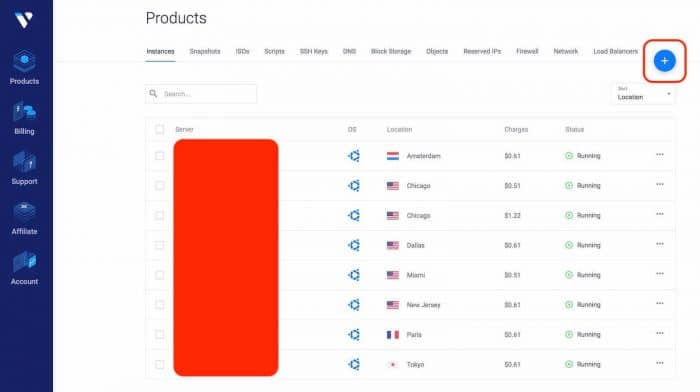
Your Dashboard will exist empty, and you can start deploying a new server ASAP but before I recommend you add your payment method.
Vultr is very flexible and they take Credit Cards, Paypal and Bitcoins as well.
Now get back to your Dashboard and click the button (I marked it in red in the image in a higher place) to deploy a new instance. Yous can select a Deject Compute instance, a Storage Instance (peachy for keeping files in the cloud like to Dropbox), a Dedicated Example, which is similar to getting a dedicated server or a High-Frequency example, which is the one we're going to utilize for this guide.
The loftier-frequency instance is my favorite equally it has better hardware specs (by and large CPU and storage speed) and they outperform all of the competitors just past paying ane extra dollar. Instead of costing $5 like the regular cloud compute instance this ane costs $6 per month and it's totally worth it.
Too, make sure you select the closest location to where you're going to run your campaigns for maximum performance and minimum latency. That's why I have several servers around the world.
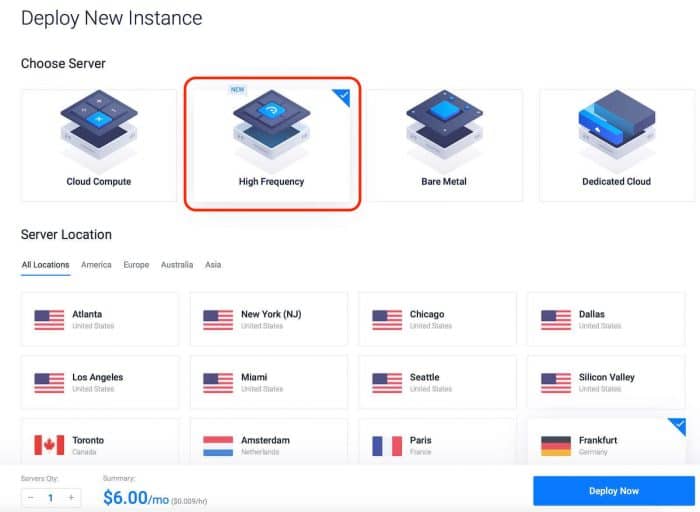
If you're running traffic in the USA, a server in the "eye" of that country like Atlanta or Dallas might perform better than a server almost the east/west declension. You also accept different locations for Europe and a couple of locations for Asia and Oceania.
I wish they had a node for Africa and possibly another in Republic of india, but so far they have more than than the contest. DigitalOcean has a node in Bharat and then if you lot're running good volumes in India yous should check that out instead.
Now you need to select your server OS or application. Nosotros're going to select an empty OS without whatsoever server applications as nosotros will install that after with a VPS managing director.
Select Ubuntu and make certain you're using versions 16.04 or 18.04 x64 similar I'll show in the post-obit film:
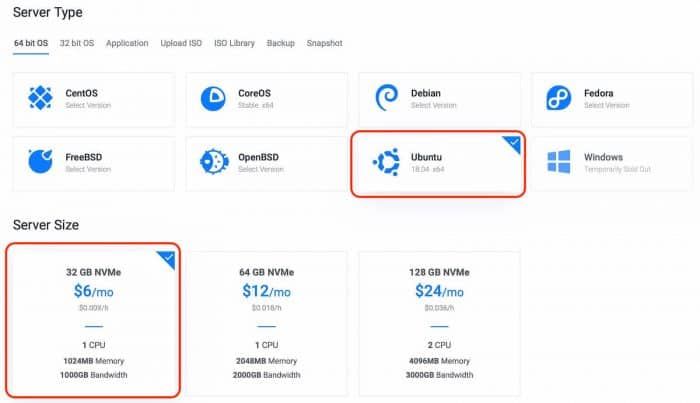
At present y'all need to select your server size. I choose the $six/calendar month VPS because that should exist enough for most people getting started. I have been able to receive around 1 million clicks per solar day in a server similar that without having performance issues. You can go the $12/month server if yous remember you're going to run high volumes from the very outset or if your landing pages are heavy and you need tons of processing power.
For nearly affiliates, the landing pages tend to be fast and simple, but you will be able to clarify your stats later and decide if y'all desire to upgrade to a fastest server, and then don't worry correct now about this.
Create your Vultr account: CLICK Here TO GET A $100 SIGN Upwardly BONUS.
Perchance the most important thing here is the bandwidth, which starts at 1,000 GB or 1 TB per calendar month. If you're running banner/button/native traffic this might be more than enough, simply if you're running PPV/pops and redirects you might desire to keep an eye on your usage (at that place's a dashboard where yous can check this) to run across if the server is handling things well and the bandwidth you've consumed through the calendar month.
- For instance, a 200Kb landing page getting xxx,000 visits per day on Facebook volition swallow effectually 6GB of data per mean solar day. That's 180GB per month which is yet just 18% of the 1TB available.
- Only a 100Kb landing page getting 3 million visits per day from popular traffic will eat 300GB of data per day or 9 TB per calendar month, and then you'll need a higher program.
Anyways, but calculate what yous need or select the $six program and check your stats through the days to meet if you lot demand to upgrade/downgrade your plan.
Finally, but exit all the residue of the forms blank and only fill the Server Label (marked in a red box below) where yous'll put the name of your server (i.e. the name of your domain for organizational purposes) and click the "Deploy Now" button.
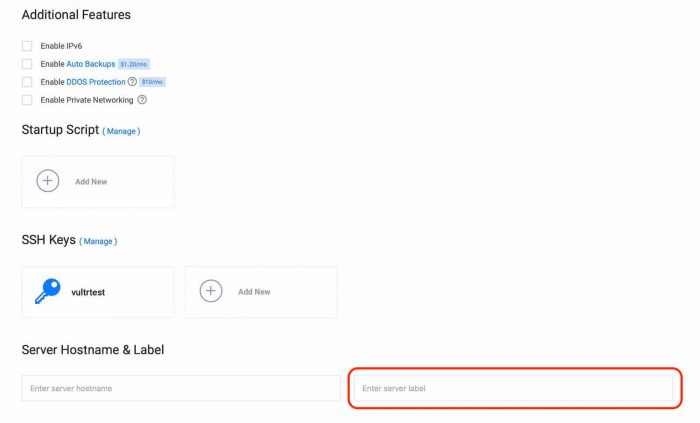
Vultr will create your server, install Ubuntu in a few minutes. You'll get an email like the one beneath when it'south been done. Afterward you lot get the email I have noticed Vultr withal needs to end upwards the installation so it's meliorate if you look five minutes before doing anything else.
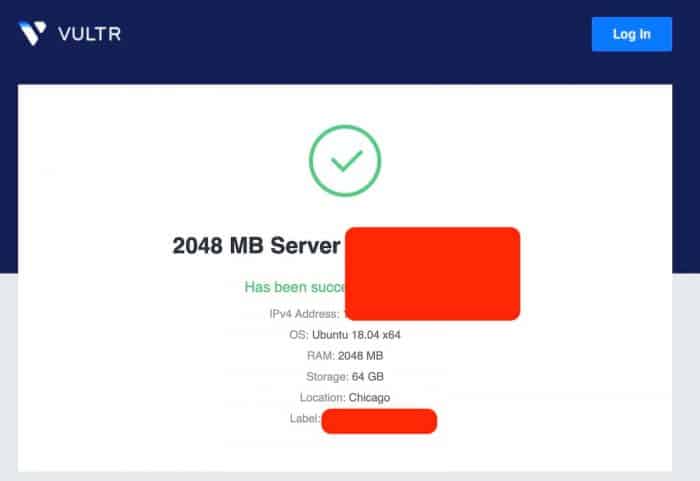
You will need the IP address from the email to set up up a few things subsequently but you have all the information for easy access in your Dashboard at present. See the image below for the important data you need to write downward including the username and password.
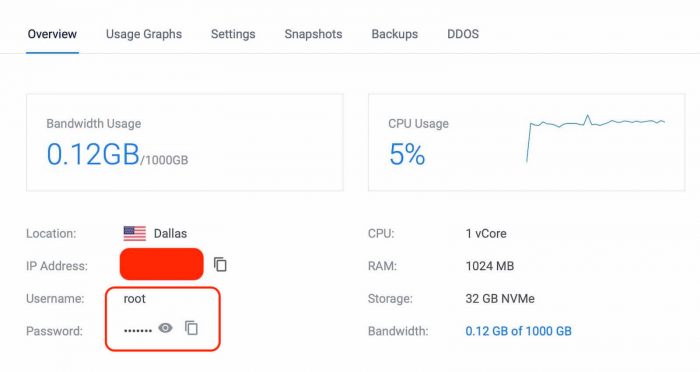
If you ever desire to upgrade the server but to to the "Settings" menu within your server'south dashboard and the "Change Plan" button on the left side. There you can choose a new plan and your server will be restarted (takes one-2 minutes) to get the new hardware specs.
Yup, information technology's that easy and you lot still get charged past the hour!
Setting up your DNS
Setting upwardly the DNS is an easy process that takes ii minutes. Outset, you need to get to your Domain provider (Godaddy, Namecheap, etc.) and ready up custom DNS for your domain pointing to:
- ns1.vultr.com
- ns2.vultr.com
If you lot're using Namecheap this is how it looks:
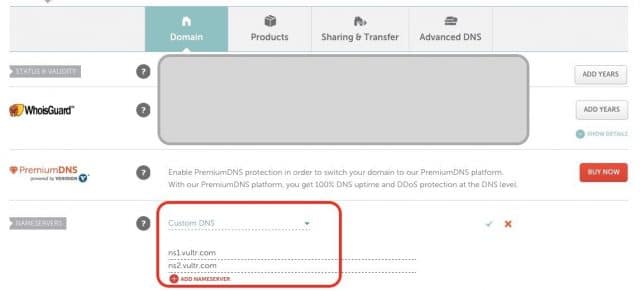
Now that your Domain provider is pointing to Vultr's servers, you need to link your server IP with your Domain. Keep in mind the domain propagation around the world tin can accept upwards to 48 hours. If yous see your domain is still pointing to a parked folio or another server only look some time or clear your browser's cache.
I prefer managing my DNS through premium DNS providers similar Cloudflare (complimentary) or DNSMadeeasy, however, I will talk about that in another article as it can become confusing.
Now go dorsum to Vultr and in the "Servers" primary carte du jour click the "DNS" submenu and click the "Add Domain" button as marked below:
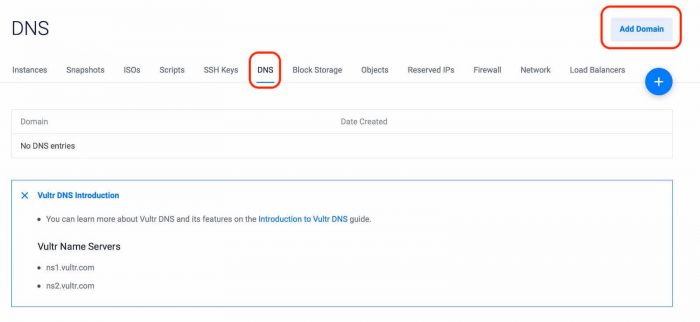
In the next step but make full out the new IP of your server (yous can bank check information technology in your server's dashboard or the email you received afterwards launching your server) and write downward the domain you're pointing from GoDaddy/Namecheap. In my example, I just wrote down "yourlander.com" as an example.
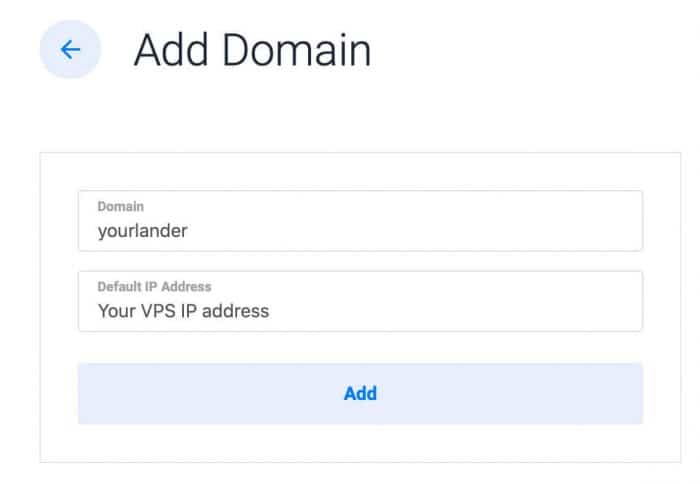
Later on yous click the "Add together" push from above, you'll see your A/CNAME/MX/NS records and yous're skillful to go.
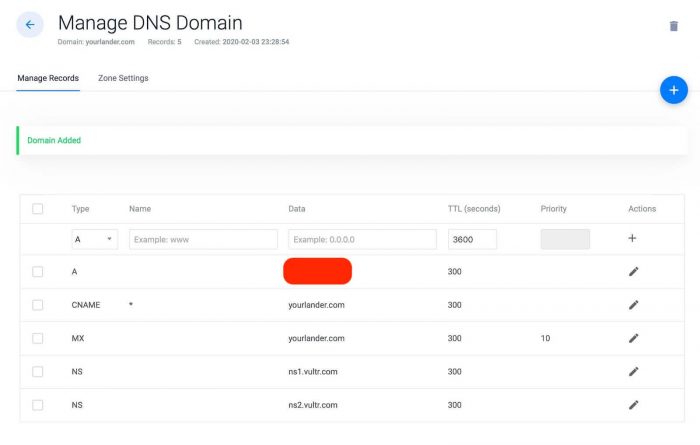
If the DNS settings take been propagated to your location you should now be able to blazon the domain in your browser and see an image with Vultr's logo or some branding. At this moment even if you don't meet anything it doesn't matter since your VPS is still empty and you need to install your server software and upload your landing pages for it to work.
Create your Vultr account: CLICK HERE TO Get A $100 SIGN UP BONUS.
Installing your stack and SSL certificate with Serverpilot
As I explained before, your server correct now has a make clean installation of Ubuntu (Bone) and it doesn't work to serve online pages yet.
Before I used to recommend setting upwardly an application direct from Vultr to install a LEMP setup but the problem was that it wasn't easy to add an SSL certificate for your domain unless you're skilful and coding and take some server knowledge.
Since virtually affiliates focus on learning marketing skills and not coding skills we're going to utilize a software that helps us install a fast server stack and also apply our SSL certificate within a few minutes.
This software is chosen Serverpilot and y'all tin sign upward right here.
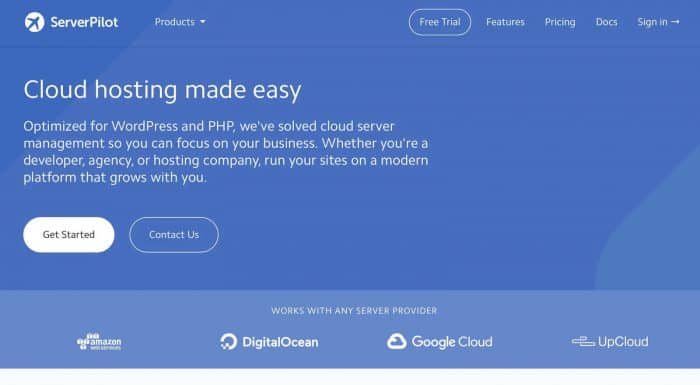
I won't explain how to create an account on Serverpilot as the procedure is super like shooting fish in a barrel. Brand certain you confirm your electronic mail as always and add a payment method (CC or PayPal) before standing with the procedure.
Once you have your account you lot will see your dashboard:
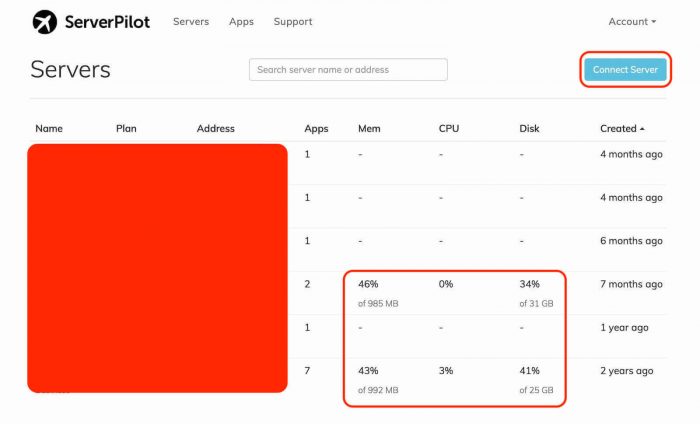
Hither you tin can see I'm managing several servers with Serverpilot and some of them have several apps (a.k.a. domains). I tin also cheque the CPI, Retentiveness and disk usage of some servers every bit I need it.
Your dashboard will exist empty and first, y'all volition need to connect your Vultr server with Serverpilot. Click the connect server button at the top correct side and you'll see the following screen:
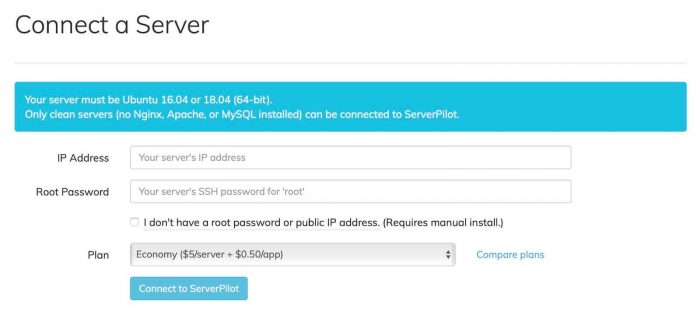
Hither, you will need to input your server IP address and root password, which you can find in your Vultr business relationship as I showed yous before. That'south why I said information technology was important to write those down but you can always go back to your VPS settings and bank check them again.
Afterward that, select the Economy plan or the business plan if you want to see the stats similar CPU/Mem/deejay usage correct in your Serverpilot business relationship. Those stats will be useful in one case you start running a good amount of traffic. Otherwise, just stick to the Economic system programme.
Once you connect to Serverpilot yous will run across a progress bar where Serverpilot prepares everything you need including installing PHP, your NGINX server, swap memory, etc. This process takes effectually 5 minutes so go grab a coffee and come up dorsum subsequently.
One time the process is done, Serverpilot will be connected to your VPS and it will ask you to create your first app.
Apps on Serverpilot are like websites or domains, so for each domain you want to use to upload landing pages, you should create an app.
Each app costs $0.5 to create while the server connection costs $five in the Economy plan. And so if you take 1 server with 4 domains you will end up paying $7 to Serverpilot. You can always delete or add new servers and apps and they will be charged by the hour, just equally Vultr does.
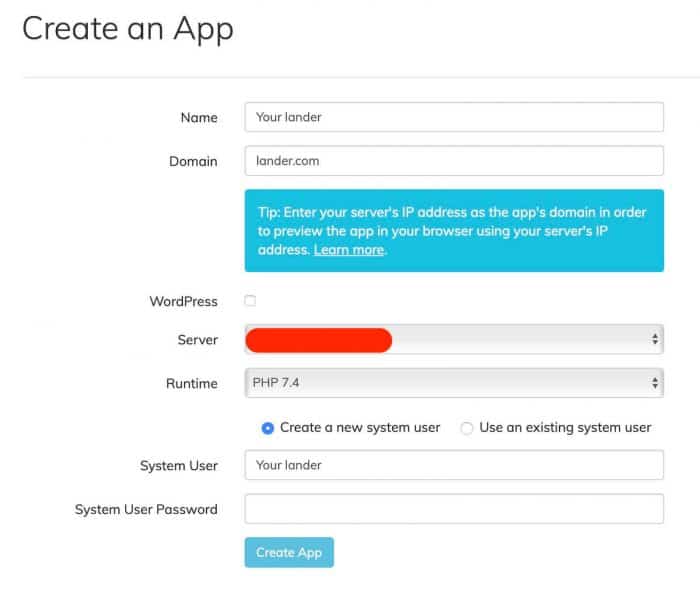
Creating an app is simple. Yous just demand to fill up the following forms:
- Name: The name of the app to be shown on Serverpilot. east.g. landingpages
- Domain: The domain you're going to prepare up with your server. This is the same domain yous pointed to Vultr's DNS earlier. e.g. landingapges.com
- WordPress. Leave this unchecked as you want to upload your own landing pages and not create a WordPress site.
- Server: select the server yous just connected from this list.
- Runtime: PHP version. If you lot're using static files (HTML/CSS) this doesn't matter, however, if you program to apply PHP in your landing pages you should use one of the latest versions like PHP vii.2 or PHP seven.3 at to the lowest degree as that's what nigh people use nowadays for maximum performance.
- System user: since information technology'due south the first fourth dimension y'all're setting upward an app on Serverpilot you tin create a user and password to have access to this app directly. Or you can still utilise your root user and password from Vultr and accept access to all of the apps in your server every bit I'll explain below.
Hitting that "create app" button and Serverpilot volition take a few seconds to create your new app.
Once this process is done, you'll take a fast server ready to run and handle a ton of visits per day and y'all can access past typing the domain into your browser.
However, the server is even so empty and you demand to upload your landing pages.
But before that, we are going to enable your SSL.
Why?
Well, most of the internet has already moved to SSL connections in the last few years. There are traffic sources that won't have your campaigns and landers if the SSL certificate is not installed and Chrome is updating their browser to prove an warning bulletin when the connection is not secure, so using an SSL certificate nowadays is a must in my opinion.
Also, it seems like cookies won't work soon if yous don't utilize an SSL connectedness then you definitely desire to practise this. I've been using SSL certificates without problems for over 3 years and I still detect some offers or affiliate landers without SSL.
Once yous create your app, this carte du jour will be shown:
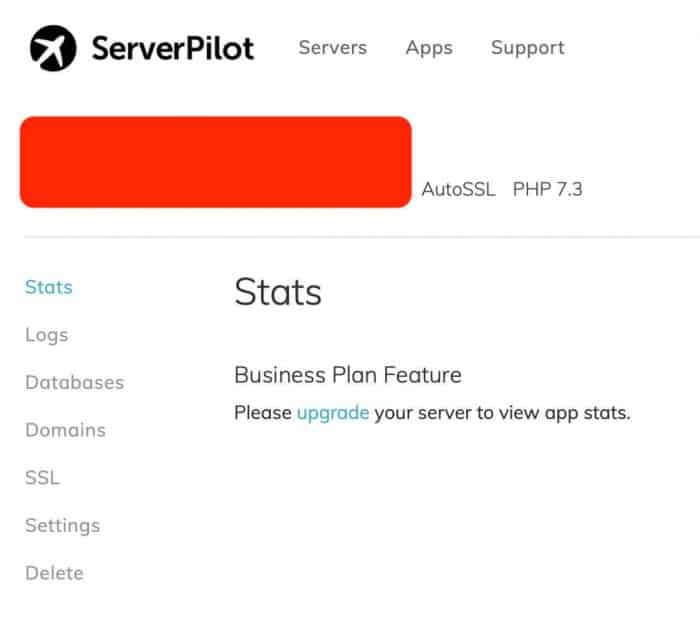
If yous're using the Economic system plan, you won't be able to see any stats but once you run some book brand sure you upgrade your plan and so you tin can check the stats of your CPU and retentivity. I prefer keeping both of them below seventy% usage at all times to exist prepared in case in that location's a traffic surge or just to proceed the response time at the fastest speeds.
Now select the SSL card on the left side and you will see this window:
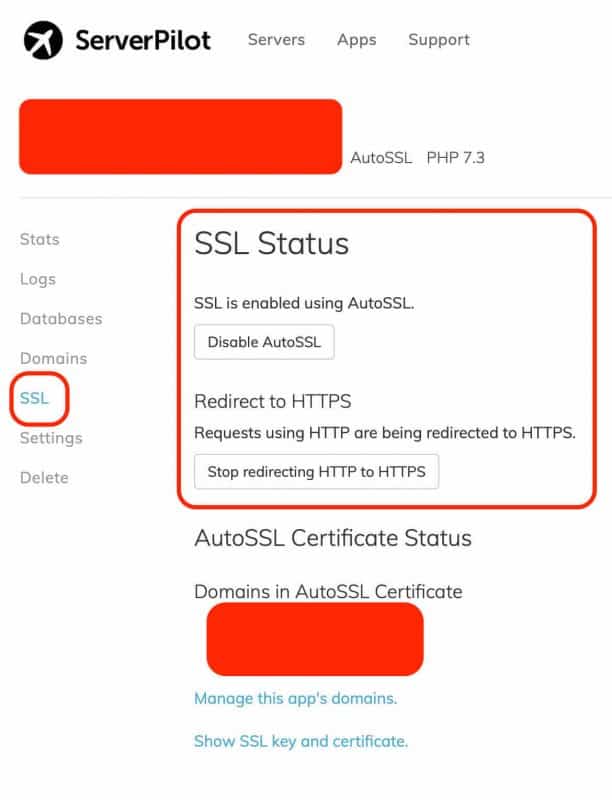
Hither, you lot will be able to enable the "Auto SSL" and "Redirect to HTTPS" options once your DNS has propagated and your server volition be fix to be used.
Sign up for a Serverpilot account hither.
There's just 1 matter left to practise.
Uploading your landers through FTP/SSH with Cyberduck
Finally!
It's time to upload your landing pages and start sending traffic! Download Cyberduck or use whatsoever other FTP customer if you have a personal preference and open up a new connectedness like the image below:
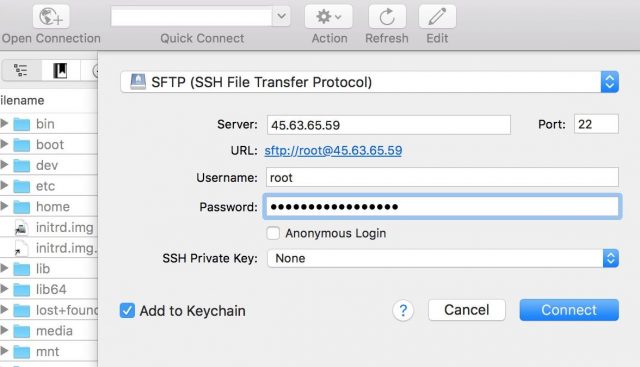
Brand sure you lot prepare an SSH connexion (secure FTP) which will open the port 22 and write downwards the IP of your VPS in the server field. Also, write the username (root) and password (yous can check them in your Vultr'due south VPS dashboard once again) and click connect.
Most probably you volition be directed to an empty folder after this, as everything has been moved to a new location within Serverpilot'south files.
Now get to the following accost: srv/users/yourserver/apps/yourapp/public
Yous need to replace yourserver by the name of your server on Serverpilot and yourapp by the proper noun of your app as well. Or just click through the folders and you will notice the desired path as shown below:
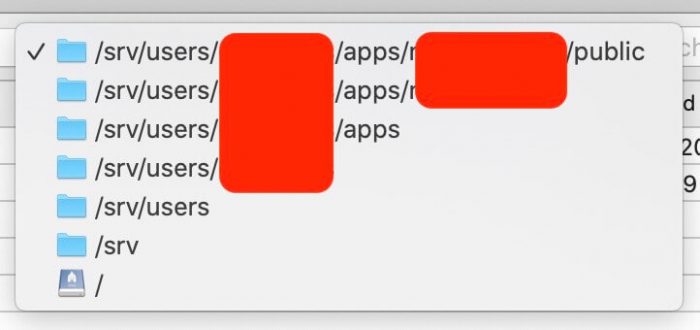
Now it's time to upload your landing pages. You can upload any file by dragging and dropping it from your estimator to Cyberduck and proper noun it as yous please.
I recommend your to create folders and organize them and then you can have as many landing pages as you want in your domain instead of just 1 landing page on the home page.
Y'all tin can host hundreds or even thousands of landers in simply 1 VPS if you use folders and organize them as long every bit you take enough infinite in your disk.
Additionally, don't forget to keep an eye on your CPU usage and bandwidth stats.
This will tell you if your server is capable of treatment the volume of traffic y'all're sending in real-time and you can also continue an eye on the bandwidth you're using to encounter if you'll need a college plan. You can do this past upgrading your Serverpilot's plan to check CPU, retentivity and disk usage, or if you want to salvage some money y'all can bank check your stats in your Vultr's dashboard (albeit it won't evidence your RAM memory stats).
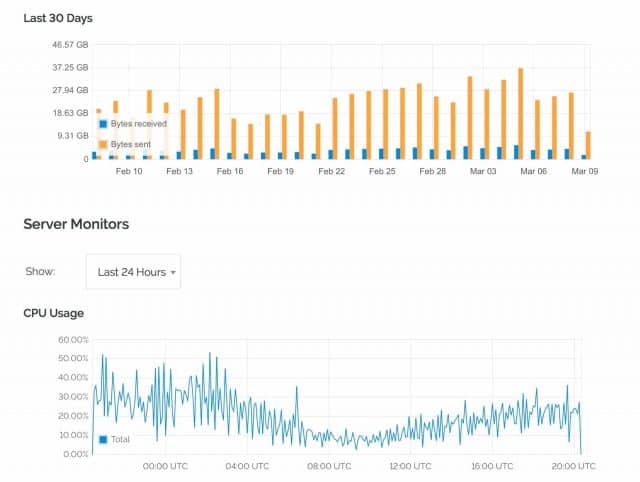
In the paradigm higher up, you tin run into a $10 per calendar month server receiving 1 1000000 visits per twenty-four hour period with a very lite (20Kb) landing page. Then far the CPU usage goes up to 40-60%, and the bandwidth consumed is around 600GB from ii,000GB (2TB) bachelor, so it'southward running fine.
Of course, I like to distribute my traffic between several servers in different locations and different plans according to the book, but you can easily upgrade your plans as I explained at the beginning of the article.
This setup generally works amend than using a CDN (if the geo is close to your server) and definitely beats a VPS/defended server in the USA from managed hosting companies when you lot're running campaigns effectually the world.
The only times where I've seen a CDN outperforms this prepare is when I buy traffic from places like South Africa or some parts of Asia where there are no servers around.
The best role is yous're merely paying $6 (Vultr) + $5.five (Serverpilot) to get a super-fast server for a total of $eleven and you lot can scale information technology up every bit you go instead of signing upwardly for a monthly contract and paying $150 for the same performance on a managed dedicated server.
Now go and create your beginning VPS + SSL and start running some traffic and enjoying your extra ROI 🙂
Source: https://servandosilva.com/upload-landing-pages-vultr/
0 Response to "How to Upload New Landing Page in Cpanel Godaddy"
Enregistrer un commentaire